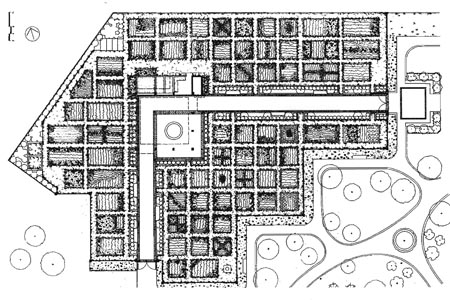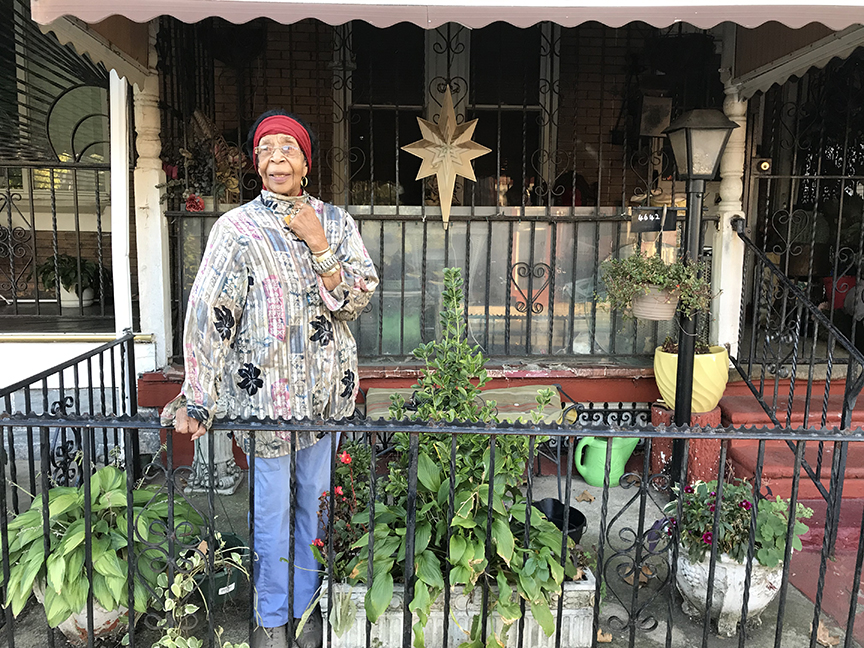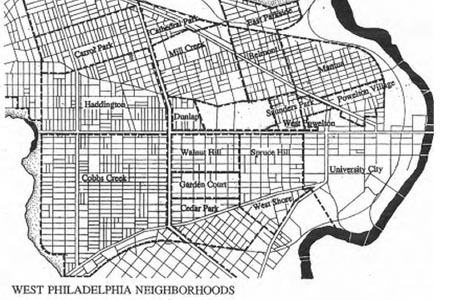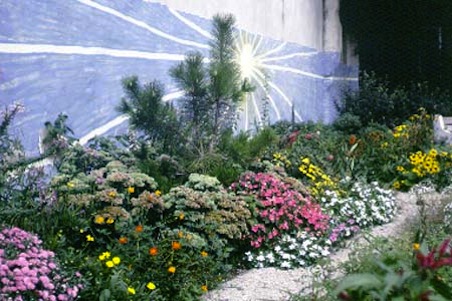Westminster Community Garden (1990)
The lot on the corner of May and Westminster Streets had been vacant for many years, full of accumulated junk and abandoned cars, when Jean Reid was elected block captain in 1984. About the same time, Mrs. Reid saw a Philadelphia Green sign on a garden down the street and decided to call them about the vacant lot across from her house. Today, that lot is a garden, designed and constructed as part of the West Philadelphia Landscape Plan and Greening Project. One person got it all started, then others pitched in.
The process of creating the garden began with a meeting between eight neighborhood residents, Philadelphia Green staff members, Denise Jefferson and Susan Ross, and Ruth Loewe, a graduate student in Landscape Architecture at the University of Pennsylvania. The neighbors wanted flowers and vegetables, a barbecue pit, a tool shed, and a place to sit. Loewe designed a garden with a curved path surrounded by flowers that leads to a meeting place in the center under an arbor. In back of this enclosed “outdoor room” are the vegetable plots.
Neighbors, including several children, worked with the Philadelphia Green construction crew and Penn Landscape Architecture students to build the garden in early summer 1988. By June, the gardeners planted flowers and vegetables and three months later reaped a rich harvest. That fall, Jean Reid, Jim Alston, and Claudette Brooks searched through dense mats of plants to find the many, hidden ripe vegetables. As they gathered tomatoes, zucchini, eggplants, and peppers, they talked about the transformation the garden had brought to the street. “We had no idea a year ago. Coming from a rubbished lot with needles… it happened overnight,” said Mrs. Reid.
At first glance, Westminster does not look like it was designed by a landscape architect. In fact, the design was more of a framework for the gardeners to embroider upon than a “finished” product. It was intended to change; and so it has. Mrs. Reid loves to shop at flea markets, and she has personalized the garden with many treasured objects: a ceramic dragon, a birdbath, a concrete bench with a lion’s claw base, an old porch chair, a grill, and an umbrella for shade. She embellished the entrance to create a welcoming gateway; two sections of wrought-iron fence now stick out from the garden gate like outstretched arms. To the right of this gate, she put an old mailbox and painted it white. At the back of the garden, Mrs. Reid hung an old black kettle in which she hopes to make stew. The pot reminds her of her childhood in the South. Mrs. Reid also raised an American flag and nailed a horseshoe on the arbor that marks the entry to the garden’s meeting place, a refuge at the center.
Within months of the garden’s construction, Mrs. Reid and her neighbors were already planning new projects. In 1989 they extended their territory onto an adjacent vacant lot, which they cleared and planted. An old car in the middle of the lot did not discourage Reid, who said she would just turn it into a huge planter for flowers. However, they did manage to get the car removed. To Mrs. Reid, the importance of the garden goes beyond a pleasant place to sit or to grow vegetables: “It’s doing something for the neighborhood.” As people have seen the results of the first garden, she has found increasing support for further projects: “Even the drunks, they want to help me do another one.”
“I said come on Jim, come help, and he said, you start and I’ll help you.”
“We had no idea a year ago. Coming from a rubbished lot with needles… it happened overnight.”
Update 2017
The Westminster Garden has flourished within its original frame. In 2017, a canopy of big green leaves spans the narrow lot, sheltering a garden room. Westminster is fundamentally the domain of Jean Reid who was and still is, thirty years after construction, the force behind the garden, which has matured under her guiding hand.
The design for the original garden was deliberately open-ended, a frame for the gardeners to fill in and embellish. Gate, fence, and trellis provided a structure for wisteria and for gardeners to hang a collection of found objects. Within a few years, the garden became a piece of folk art.
The garden was also a catalyst for other projects on the 4600 block of Westminster Avenue. Mrs. Reid decorated several porches across the street with found objects and transformed a vacant lot next to her house into another garden. In 2017, the Westminster garden still thrives. Mrs. Reid now finds it difficult to maintain the garden herself, so she enlists the help of her son and her renters.






